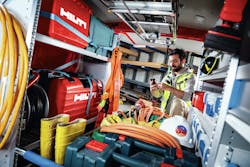How Telematics Technology Simplifies Equipment and Inventory Management
The term “telematics” may be unfamiliar to some, but it’s a technology that’s growing in popularity in the heavy equipment industry. Telematics is a digital asset management system that uses IoT— the Internet of Things — technology to monitor equipment inventory and track maintenance status of machinery like cranes, bulldozers, fleet vehicles, generators and more. Operations directors, Fleet managers and purchasing executives are taking note, particularly those who have teams working on multiple projects at a time and where inventory and equipment tracking can be especially challenging
Fortunately for organizations, forward-thinking construction technology company, Hilti, has time and labor-saving offerings to tackle these obstacles.
Eric Weddle, product manager of tool services at Hilti, explains, “With our Bluetooth-enabled telematics platform, organizations simply place equipment tags on everything they’d like tracked and managed. Users then access Hilti’s ON!Track application to pinpoint the location of their tools and machinery by using the internet or cellular data.” This information can be accessed from a computer, tablet or phone -anywhere that internet access is available.
VIM (Van Inventory Management) and HEM (Heavy Equipment Management) are both telematics solutions supported by Hilti. VIM is a van gateway that allows companies to remotely access the inventory carried in any of the connected vehicles within their fleet; HEM provides key data for heavy equipment usage, location and maintenance requirements.
Working Smarter
While many companies report that the implementation of new processes tends to have a low adoption rate, construction technology companies like Hilti make onboarding and implementation as easy as possible. “It’s important to us to make this process automated so that field workers don’t have to add new, manual processes to their already busy daily workload,” says Weddle.
For heavy equipment, a certified third-party installer visits the job site to set up tracking tags for all the machines that will be monitored. After that, the customer can add machines to the app themselves, or reach out to have their assigned Hilti solutions consultant complete the process. Either way, the process can be relatively hands-off for jobsite workers. Weddle notes, “This way, telematics set-up can happen behind the scenes, causing minimal disruption during the initial onboarding.”
An integrated system also creates consistency, allowing all equipment tracking to utilize a single source of information. Weddle shares, “We hear from customers that their software stacks are far too varied. ON!Track addresses these pain points, allowing them to consolidate their software use. With VIM-HEM telematics, they’re able to handle all of their equipment tracking from a single database instead of using different solutions for different types of equipment—ultimately saving time and helping minimize frustration.”
Industry data shows that over two-thirds of a trade worker’s time is typically spent on non-productive work, with a big chunk dedicated to resource management.
“That time sink can increase when tools are misplaced, stolen, or in need of unplanned maintenance," says Weddle.
By combining the digitized telematics process with Hilti’s Tool Fleet Management program, workers can swap costly tool ownership with a flexible subscription model. This gives equipment managers on-demand access to the best tools required for every application while also bundling repairs, maintenance and replacements into a flat, monthly fee.
This new approach to tool crib management—outsourcing through a subscription model as opposed to owning all of your equipment outright—can help organizations control costs, scale more efficiently, and compete for new projects without having to purchase additional tools.
An Evolving Technology
While Hilti's ON!Track solution has enabled customers to digitally track tools and manage assets for close to a decade, the launch of the all-on-one Nuron cordless battery platform took this a step further by delivering deeper insights via smart batteries and cloud-connectivity. Nuron battery chargers have SIM cards built into the adapters, providing users with real-time, remote access to information about battery-powered tool usage. This added transparency can help construction professionals make better business decisions based on which tools are being used and where.
Additionally, all Nuron tools run on Hilti’s 22V platform, meaning workers can perform light, medium, or heavy-duty applications with the same interchangeable battery. As a result, jobsites can consolidate their tool crib and save time previously spent searching for tool-specific batteries. And with higher run time plus added safety innovations such as Dust Removal Systems (DRS), Active Torque Control (ATC), Active Vibration Reduction (AVR), and tethering options, Nuron equips workers with the equipment they need to perform tasks more efficiently, safely and comfortably.
“Our vehicle and heavy equipment gateway solution is a continuation of our journey to help digitize the construction industry,” says Weddle. “Instead of solely relying on batteries or chargers to capture tool usage and location information, our customers can yield this same data through Bluetooth asset tags.”
In fact, ON!Track can monitor any tool or device from any manufacturer, as long as it is equipped with an asset tag. This software enables users to:
- Manage supplies
- Receive low-stock alerts
- Check safety and compliance requirements
- Schedule maintenance and repairs
- Access equipment documentation
- Gain insights into what needs to be replaced
Another important innovation in telematics is the ability to help mitigate tool theft. Customers receive alerts if items are moved during non-working hours, or from their designated locations.
The Future Is Now
In the past, equipment and inventory tracking was an inexact and time-consuming operation. To combat this, organizations have historically over-purchased equipment to help ensure every jobsite has what they need. But, with cloud-based software like ON!Track, over-inflated tool cribs and limited inventory visibility can become a thing of the past.
ON!Track is designed to provide transparency into what assets customers have, and where their inventory is located, at any given moment; with all data easily accessible through a user-friendly interface. This allows for leaner management of tool cribs as it reduces unnecessary over-purchasing for assets thought to be lost or stolen. “Both the desktop version and phone app are designed to be as intuitive as possible,” says Weddle. “There are simple prompts about how to add or edit assets and materials, how to transfer them from a warehouse to a job site, or an individual, and back again.”
Remote inventory checks are also possible. Weddle notes that in the past, users had to manually track assets back and forth. With VIM and HEM gateways, Bluetooth tags within a 100-foot radius of a connected vehicle are identified and automatically assigned to its nearest tool crib, without manual intervention. “This gives our customers valuable time back in their daily workflows while reducing the likelihood of human error,” he adds.
It's the wave of the future. Without the need for manual monitoring of equipment inventory and usage, workers are considerably more efficient, and equipment is protected against theft, maintenance issues and loss. Click here to see how connected tool services can benefit your organization.







